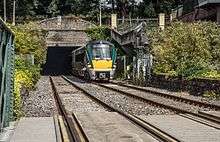Phoenix Park Tunnel
 Southern end of the tunnel | |
| Overview | |
|---|---|
| Other name(s) | Tollán Pháirc na Fhionnuisce |
| Location | Dublin, Ireland |
| Coordinates | 53°20′51″N 6°18′12″W / 53.3474°N 6.3033°WCoordinates: 53°20′51″N 6°18′12″W / 53.3474°N 6.3033°W |
| Route | Heuston Station to Dublin-Sligo railway line |
| Start | Dublin Heuston railway station |
| End | Dublin-Sligo railway line |
| Operation | |
| Opened | 1877 |
| Owner | Iarnród Éireann |
| Operator | Iarnród Éireann |
| Character | Through-rail passenger and freight |
| Technical | |
| Line length | 690 metres (2,300 ft) |
| No. of tracks | Double track |
| Track gauge | Irish gauge |
| Electrified | Not electrified |
| Operating speed | 20mph |
The Phoenix Park Tunnel is a railway tunnel in Dublin, Ireland. The tunnel was built in 1877 and begins at the Liffey Railway Bridge near Heuston Station, running underneath the Phoenix Park for 690 metres before re-emerging close to the junction of the Cabra Road and Navan Road.[1] It joins with the Sligo line near Glasnevin, before continuing to Dublin Connolly.
The tunnel was originally built by the Great Southern and Western Railway company to connect Kingsbridge station to the Dublin Docklands,[2] and primarily used for freight. Historically the line had not been used for regular passenger trains, with most traffic through the tunnel being freight or carriages and engines shunted between Connolly and Heuston for maintenance. It had occasionally been used for special passenger services, including traffic for major Gaelic Athletic Association fixtures.[3]
It reopened on 21 November 2016 for regular passenger traffic.[4]
References
- ↑ "A train trip through the 138-year-old Phoenix Park Tunnel". Irish Times. 20 August 2013.
- ↑ "Renovation work on 138-year-old Phoenix Park railway tunnel commences". Independent News & Media. 18 August 2015.
- ↑ Fegan, Joyce. "Plans for four trains an hour in Phoenix Park tunnel next year". Irish Independent. Retrieved 5 May 2015.
- ↑ Conor Pope (2016-11-21). "Passenger trains use Phoenix Park tunnel for first time in 100 years". Irish Times. Retrieved 2016-11-21.